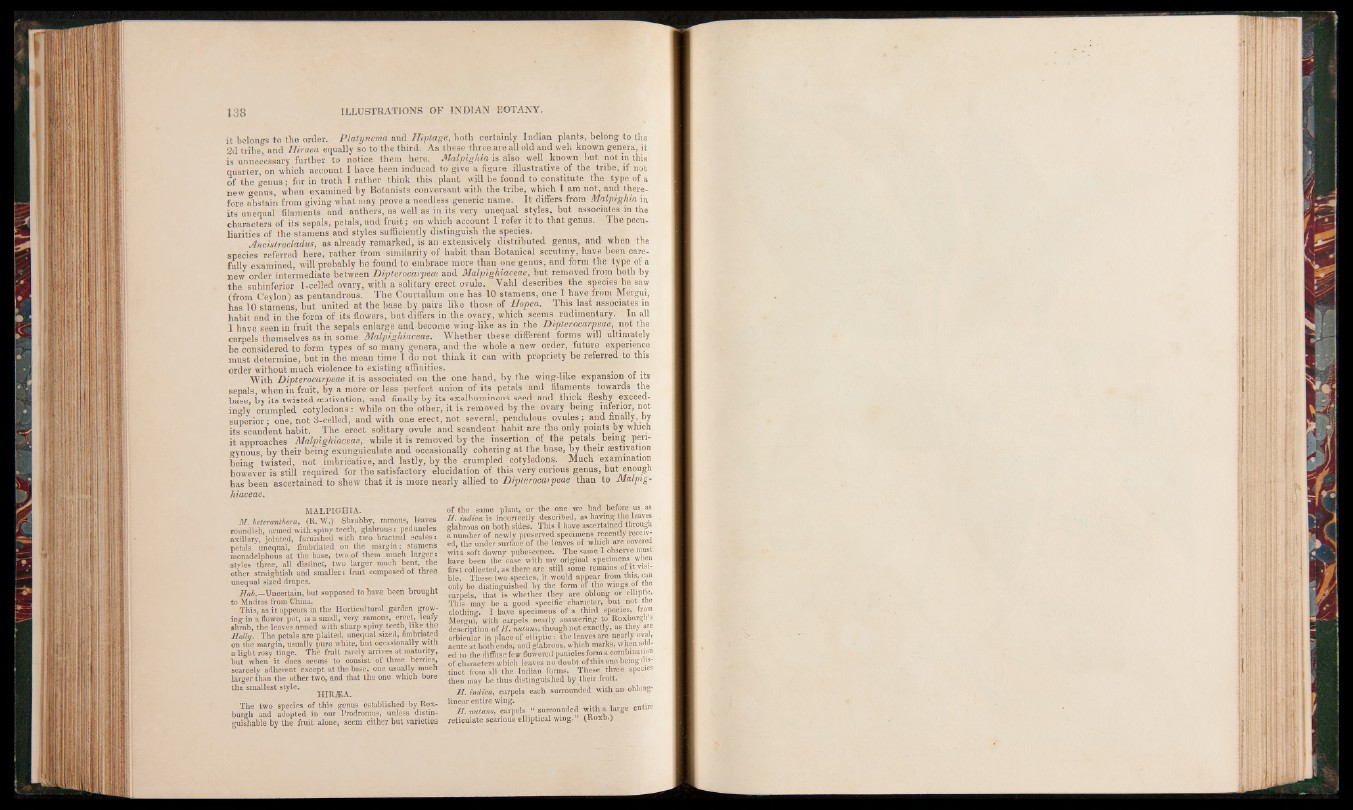
it belongs to the order. Platynema and Hiptage, both certainly Indian plants, belong to the
2d tribe and Hiraea equally so to the third. As these three are all old and well known genera, it
is unnecessary further to notice them here. Malpig/iia is also well known hut not in this
quarter, on which account I have been induced to give a figure illustrative of the tribe, if not
of the genus ; for in truth I rather think this plant will be found to constitute the type of a
new genus, when examined by Botanists conversant with the tribe, which I am not, and therefore
abstain from giving what may prove a needless generic name. It differs from Ma.lpi.ghia in
its unequal filaments and anthers, as well as in its very unequal styles, but associates in the
characters of its sepals, petals, and fruit; on which account I refer it to that genus. The peculiarities
of the stamens and styles sufficiently distinguish the species.
Ancistrocladus, as already remarked, is an extensively distiihuted genus, and when the
species referred here, rather from similarity of habit than Botanical scrutiny, have been carefully
examined, will probably he found to embrace more than one genus, and form the type of a
new order intermediate between Dipterocarpeae and Malpighiaceae, but removed from both by
the subinferior 1-celled ovary, with a solitary erect ovule. Vahl describes the species he saw
(from Ceylon) as pentandrous. The Courtallum one h a i 10 stamens, one I have from Mergui,
has 10 stamens, but united at the base by pairs like those of llopea. This last associates in
habit and in the form of ,its flowers, but differs in the ovary, which seems rudimentary. In all
I have seen in fruit the sepals enlarge and become wing-like as in the Dipterocarpeae, not the
carpels themselves as in some Malpighiaceae. Whether these different forms will ultimately
he considered to form types of so many genera, and the whole a new order, future experience
must determine, but in the mean time I do not think it can with propriety be referred to this
order without much violence to existing affinities. . . . .
With Dipterocarpeae it is associated on the one hand, by the wing-like expansion ot its
sepals, when in fruit, by a more or less perfect union of its petals and filaments towards the
base by its twisted aestivation, and finally by its exalbuminouS seed and thick fleshy exceedingly
crumpled cotyledons : while on the other, it is removed by the-'Ovary being inferior, not
superior; one, not 3-celled, and with one erect, not several, pendulous ovules; and finally, by
its scandent habit. The erect solitary ovule and scandent habit are the only points by which
it approaches Malpighiaceae, while it is removed by the insertion of the petals being pen-
gynous by their being exunguiculate and occasionally cohering at the base, by their aestivation
being twisted, not imbricative, and lastly, by the crumpled cotyledons. Much examination
however is still required for tbe satisfactory elucidation of this very curious genus., but enough
has been ascertained to shew that it is more nearly allied to Dipterocarpeae than to Malpig-
hiaceac.
MALPIGHIA.
M . hetermithera, (R. W.) Shrubby, ramous, leaves
roundish, armed with spiny teeth, glabrous: peduncles
axillary, jointed, furnished with two bracteai scales:
petals unequal, fimbriated on the margin: stamens
monadelphous at the base, two.of them much larger:
styles three, all distinct, two larger much bent, the
other straightish and smaller: fruit composed of three
unequal sized drupes.
Hab.—Uncertain, but supposed to have been brought
to Madras from China.
This, as it appears in the Horticultural garden growing
in a flower pot, is a small, very ramous, erect, leafy
shrub, the leaves armed with sharp spiny teeth, like the
Holly. The petals are plaited, unequal sized, fimbriated
on the margin, usually pure white, but occasionally with
a light rosy tinge. The fruit rarely arrives at maturity,
but when’ it does seems to consist of three berries,
scarcely adherent except at the base, one usually much
larger than the other two, and that the one which bore
the smallest style.
HIRiEA.
The two species of this genus established by Roxburgh
and adopted in our Prodromus, unless distinguishable
by the fruit alone, seem either but varieties
of the same plants or the one we had before us as
H . indica is incorrectly described, as having the leaves
glabrous on both sides. This I have ascertained through
a number of newly preserved specimens recently received,
the under surface o f the leaves of which are covered
with soft downy pubescence. The .same I observe must
have been the case with my original specimens when
first collected, as there are still some remains of it visible.
These two species, it would appear from this, can
only be distinguished by the form of the wings of the
carpels, that is whether they are oblong or elliptic.
This may be a good specifier character, but not the
clothing. I have specimens of a third species, from
Mergui, with carpels nearly answering to Roxburgh s
description of H . nutans, though not exactly, as they are
orbicular in place of elliptic; the leaves are nearly oval,
acute at both ends, and glabrous, which marks, when added
to the diffuse few flowered panicles form a combination
of characters which leaves no doubt of this one being is
tinct from all the Indian forms. These three species
then may be thus distinguished by their fruit.
H . indica, carpels each surrounded~with ml oblong-
linear entire wing.
H . nutans, carpels “ surrounded with a large entire
reticulate scarious elliptical wing.” (Roxb.)